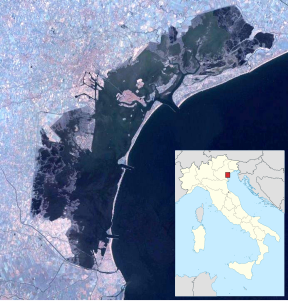Ottagono Ca 'Roman
| Ottagono Ca 'Roman | ||
|---|---|---|
| Waters | Venice lagoon | |
| Geographical location | 45 ° 14 '36 " N , 12 ° 17' 2.5" E | |
|
|
||
| surface | 0.202 3 ha | |
| Residents | uninhabited | |
Ottagono Ca 'Roman is a small island in the southern lagoon of Venice . It has an area of 2,023 m² and, as one of the four octagonal fortresses, guarded the southernmost entrance to the lagoon from the 16th to the 20th century. The area around the island is considered to be one of the ecologically best preserved sections of the lagoon.
history
In view of the wars with the Ottomans , which culminated in the naval battle of Lepanto in 1571 , the Senate of the Republic of Venice decided to militarily secure the entrances to the lagoon. For this purpose, four octagonal fortresses (ottagoni) were to be built. The island of Alberoni, together with the fortress on Campana and Poveglia, formed a line of defense against intruders into the entrance of Malamocco.
During the war for the Cretan Candia , which occupied Venice from 1646 to 1669, the island was fortified even more. After that, however, the Ottagoni were neglected until renewed modernizations took place from 1726. As early as 1870, the island was known by its current name, which means nothing more than abandoned octagon. The decline began at that time and has continued since then.
The French integrated the island into their defense system from 1806 to 1814. The Austrians also reinforced the island with casemates and additional cannons. Above all the side facing the Adriatic was expanded. A platform for the artillery was probably built during World War II .
Today the island is deserted and reclaimed by the vegetation.
Web links
- Ottagono Ca 'Roman, website of the Comune di Venezia ( memento of September 19, 2009 in the Internet Archive ), September 19, 2009
Remarks
- ↑ Venice Islands ( memento of March 24, 2009 in the Internet Archive ).
- ↑ Attività di rilevamento per il monitoraggio degli effetti prodotti dalla costruzione delle opere alle bocche lagunari , report of the Consorzio per la gestione del Centro di Coordinamento delle Attività di Ricerca inerenti il Sistema Lagunare di Venezia (CORILA), Venice, February 15, 2007, Venice, February 15, 2007 3.

